
The Oscar class, Soviet designations Project 949 Granit and Project 949A Antey, are a series of nuclear-powered cruise missile submarines designed in the Soviet Union for the Soviet Navy. First built in the 1970s, six remain in service with the Russian Navy. Two other vessels were slated to be modernized since at least 2017 as Project 949AM, to extend their service life and increase combat capabilities but it is unclear whether work continues as of 2023.
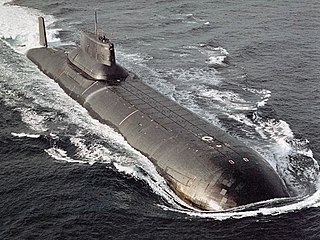
The Project 941 Akula, was a class of nuclear-powered ballistic missile submarines designed and built by the Soviet Union for the Soviet Navy. With a submerged displacement of 48,000 t, the Typhoons were the largest submarines ever built, able to accommodate comfortable living facilities for the crew of 160 when submerged for several months. The source of the NATO reporting name remains unclear, although it is often claimed to be related to the use of the word "typhoon" ("тайфун") by General Secretary Leonid Brezhnev of the Communist Party in a 1974 speech while describing a new type of nuclear ballistic missile submarine, as a reaction to the United States Navy's new Ohio-class submarine.
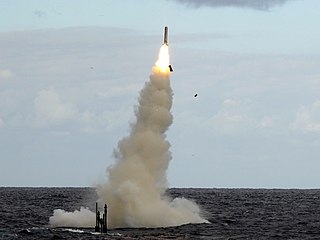
A submarine-launched cruise missile (SLCM) is a cruise missile that is launched from a submarine. Current versions are typically standoff weapons known as land-attack cruise missiles (LACMs), which are used to attack predetermined land targets with conventional or nuclear payloads. Anti-ship cruise missiles (ASCMs) are also used, and some submarine-launched cruise missiles have variants for both functions.
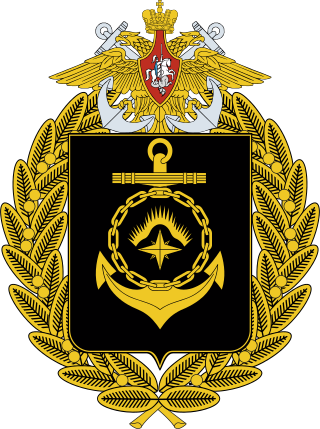
The Northern Fleet is the fleet of the Russian Navy in the Arctic.

The Borei class, alternate transliteration Borey, Russian designation Project 955 Borei and Project 955A Borei-A, are a series of nuclear-powered ballistic missile submarines being constructed by Sevmash for the Russian Navy. The class has been replacing the steadily retiring Russian Navy Delta III and Delta IV classes and fully retired Typhoon, all three classes being Soviet-era submarines.

The Russian cruiser Marshal Ustinov, is a Slava-class cruiser of the Russian Navy. The Russian name for the ship type is Raketnyy Kreyser (RKR), meaning "Missile Cruiser". The ship is named after Dmitriy Ustinov, a former Soviet Minister of Defence. Marshal Ustinov was assigned to the 43rd Missile Ship Division of the Russian Northern Fleet, whose homeport is in Severomorsk. From 2012 to 2016, the cruiser underwent a major overhaul. The vessel returned to service in 2017 and has since been deployed to the Mediterranean Sea.

The Sierra class, Soviet designations Project 945 Barrakuda and Project 945A Kondor,, are a series of nuclear-powered attack submarines intended for the Soviet Navy and currently in service with the Russian Navy.

The Steregushchiy class, Russian designation Project 20380, is a class of corvettes being built for the Russian Navy. Designed by the Almaz Central Marine Design Bureau, subsequent vessels were built to an improved design, incorporating the Zaslon-Redut SAM system. The ship full displacement and dimensions are large for a corvette, thus it is designated as a frigate by NATO. The Steregushchiy class has been further developed into the Gremyashchiy class and Project 20386 subclasses. The export variant is known as Project 20382 Tigr.

The Yasen class, Russian designations Project 885 Yasen and Project 885M Yasen-M, also referred to as the Graney class, are a series of nuclear-powered cruise missile submarines designed by the Malakhit Marine Engineering Bureau and built by Sevmash for the Russian Navy. Design work commenced in earnest in the 1980s with the first submarine built in the 1990s–early 2010s with commissioning in 2013. Two additional boats to an upgraded Yasen-M design were commissioned in 2021 and six more are under construction. Based on the Akula class and Alfa class designs, the Yasen class is projected to replace the Russian Navy's current Soviet-era nuclear attack submarines. The Akula class is optimised for a hunter-killer role, whereas the Yasen class concept uses the platform as a nuclear guided missile submarine (SSGN).
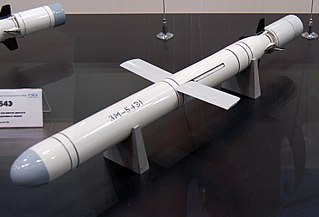
The Novator Kalibr, also referred to as 3M54-1 Kalibr, 3M14 Biryuza, is a family of Russian cruise missiles developed by NPO Novator (OKB-8). It first saw service in 1994. There are ship-launched, submarine-launched and air-launched versions of the missile, and variants for anti-ship, and land attack use. Some versions have a second propulsion stage that initiates a supersonic sprint in the terminal approach to the target, reducing the time that air defense systems have to react, while subsonic versions have greater range than the supersonic variants. The missile can carry a warhead weighing up to 500 kilograms (1,100 lb).

JSC PO Sevmash is a Russian joint-stock company (JSC) under the vertically-integrated United Shipbuilding Corporation. The shipbuilding operations of Sevmash is in the port city of Severodvinsk on the White Sea in the Russian Federation.

K-561 Kazan is a Yasen-class nuclear-powered cruise missile submarine of the Russian Navy. It is the second boat of the project, separated from the first by 16 years (1993–2009). Considerable changes were made to the initial design. Differences in the project have appeared sufficient to consider it as a new upgraded version Yasen-M. The submarine is named after the city of Kazan. The submarine is deployed with the Russian Northern Fleet.

K-114 Tula is a Russian Project 667BDRM Delfin-class nuclear-powered ballistic missile submarine (SSBN). As such, she carries a complement of R-29RM Shtil and R-29RMU Sineva nuclear submarine-launched ballistic missiles (SLBM) as her primary deterrent mission, along with anti-ship missiles and torpedoes, the latter for self-defense. Built in Severodvinsk during the late 1980s, she served with the Soviet Navy before being transferred to the Russian Navy following the dissolution of the Soviet Union. Tula underwent an extensive overhaul during 2000–2004 and was fitted with upgraded Shtil SLBMs, several of which were launched from her during her later operational life. She was sponsored by the city of Tula, and is homeported in Gadzhiyevo.
Following the dissolution of the Soviet Union at the end of 1991, the Russian Navy struggled to adjust Cold War force structures while suffering severely with insufficient maintenance and a lack of funding. However, there were improvements in the Russian economy over the first decade of the twenty-first century. The economy and standard of living grew rapidly during the early period of Putin's regime, fueled largely by a boom in the oil industry. This led to a significant rise in defence expenditure and an increase in the number of ships under construction.

The 3M22 Zircon, also spelled as Tsirkon is a Russian scramjet-powered, nuclear-capable hypersonic cruise missile. Produced by NPO Mashinostroyeniya for the Russian Navy, the missile utilizes the 3S-14 launch platforms on frigates and submarines. The missile has a reported top speed of Mach 9. The weapon was first used during Russia's invasion of Ukraine.
K-573 Novosibirsk is a Yasen-class nuclear-powered cruise missile submarine of the Russian Navy. It is the second boat of the project Yasen-M. Considerable changes were made to the initial Yasen design. Differences in the project have appeared sufficient to consider it as a new upgraded version Yasen-M. The submarine is named after the city of Novosibirsk.
The K-119 Voronezh is an Oscar-class submarine in the Russian Navy.
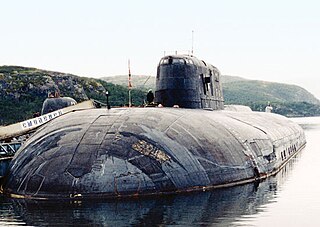
The K-410 Smolensk is an Oscar-class submarine in the Russian Navy.
K-571 Krasnoyarsk is a Yasen-class nuclear-powered cruise missile submarine of the Russian Navy. It is the third boat of the project Yasen-M. Considerable changes were made to the initial Yasen design. Differences in the project have appeared sufficient to consider it as a new upgraded version Yasen-M. The submarine is named after the city of Krasnoyarsk.
















